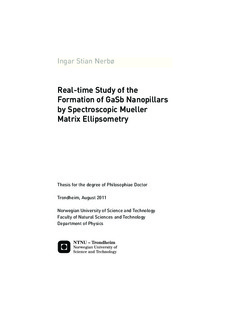| dc.contributor.author | Nerbø, Ingar Stian | nb_NO |
| dc.date.accessioned | 2014-12-19T13:17:17Z | |
| dc.date.available | 2014-12-19T13:17:17Z | |
| dc.date.created | 2011-12-01 | nb_NO |
| dc.date.issued | 2011 | nb_NO |
| dc.identifier | 460800 | nb_NO |
| dc.identifier.isbn | 978-82-471-2970-8 (printed ver.) | nb_NO |
| dc.identifier.isbn | 978-82-471-2972-2 (electronic ver.) | nb_NO |
| dc.identifier.uri | http://hdl.handle.net/11250/246599 | |
| dc.description.abstract | The formation of GaSb nanopillars have been studied in real-time by spectroscopic Mueller matrix ellipsometry. Low energy ion sputtering of GaSb leads to the formation of densely packed nanopillars on the surface. A graded anisotropic effective medium model was developed to characterize the structures from ellipsometry measurements; based on ex situ ellipsometry, atomic force microscopy, scanning electron microscopy and transmission electron microscopy. This model was applied to derive the height of the nanopillars from real-time ellipsometry measurements during sputtering. The real-time observations revealed an interesting and surprising evolution of the GaSb nanostructures. The formation could be divided into three regimes; first an initial stage with removal of oxide and some delay, followed by a second regime with a rapid and steady increase of the pillar height, and finally the formation changes to a third regime with a slow and linear increase of the pillar height. The dependence of the formation on experimental conditions, such as the temperature and the flux and energy of the ion beam, was studied. It was found that the ion flux determines the timescale of the formation, while the pillar height scale and late stage formation rate was controlled by the energy and the temperature.
The real-time observations of GaSb during sputtering provide new insight into why the GaSb nanopillars are formed. Traditionally the formation of patterns on GaSb during sputtering was explained by the Bradley–Harper model, where the structures are formed by a competition between curvature dependent sputtering yield and diffusion. However, this model can not explain the observation of the three different formation regimes. Instead, the real-time observations of the nanopillar formation supports the self sustained etch masking mechanism [S. Le Roy et al. Journal of Applied Physics 106 094308 (2009)]. In this explanation, the pillars are formed due to segregation of Ga and the difference in sputtering yield between Ga and Sb.
GaSb nanopillars with a height of less than 100 nm were found to have uniaxial optical properties, with the optical axis parallel to the pillar axis. For larger structures, the uniaxial effective medium model was not able to represent the optical properties of the pillars. For sputtering with an ion energy of 500 eV, nanopillars with a height up to 300 nm can be formed. By real-time Mueller matrix measurements of the formation of such pillars, it was observed that the pillars had biaxially optical properties as the height surpassed 100 nm. Fourier analysis of a scanning electron microscope image of the final nanopillars showed that the lateral anisotropy can be attributed to a direction dependent nearest neighbor distance. Each individual pillar has uniaxial symmetry; the biaxial symmetry comes from the anisotropic organization of the pillars.
A commercial Mueller matrix ellipsometer was applied for the real-time measurements, based on ferroelectric liquid crystals as polarization modulating elements. Improvements of such a system were proposed by optimizing the design with a genetic algorithm. The new design promise to reduce the measurement noise significantly compared to previous designs, in addition to extending the spectral range into the infrared | nb_NO |
| dc.language | eng | nb_NO |
| dc.publisher | Norges teknisk-naturvitenskapelige universitet, Fakultet for naturvitenskap og teknologi, Institutt for fysikk | nb_NO |
| dc.relation.ispartofseries | Doktoravhandlinger ved NTNU, 1503-8181; 2011:208 | nb_NO |
| dc.relation.haspart | Nerbo, I. S.; Kildemo, M.; Le Roy, S.; Simonsen, I.; Sondergard, E.; Holt, L.; Walmsley, J. C.. Characterization of nanostructured GaSb. Applied Optics. (ISSN 0003-6935). 47(28): 5130-5139, 2008. <a href='http://dx.doi.org/10.1364/AO.47.005130'>10.1364/AO.47.005130</a>. | nb_NO |
| dc.relation.haspart | Nerbo, I. S.; Le Roy, S.; Kildemo, M.; Sondergard, E.. Real-time in situ spectroscopic ellipsometry of GaSb nanostructures during sputtering. Applied Physics Letters. (ISSN 0003-6951). 94(21): 213105, 2009. <a href='http://dx.doi.org/10.1063/1.3133350'>10.1063/1.3133350</a>. | nb_NO |
| dc.relation.haspart | Nerbo, I. S.; Le Roy, S.; Foldyna, M.; Kildemo, M.; Sondergard, E.. Characterization of inclined GaSb nanopillars by Mueller matrix ellipsometry. Journal of Applied Physics. (ISSN 0021-8979). 108(1): 014307, 2010. <a href='http://dx.doi.org/10.1063/1.3386460'>10.1063/1.3386460</a>. | nb_NO |
| dc.relation.haspart | Le Roy, Sebastien; Søndergård, Elin; Ingar Stian, Nerbø; Morten, Kildemo. In-situ and real time study of the formation of nanopatterns on GaSb by ion abrasion. . | nb_NO |
| dc.relation.haspart | Nerbo, Ingar Stian; Le Roy, Sebastien; Foldyna, Martin; Sondergard, Elin; Kildemo, Morten. Real-time in situ Mueller matrix ellipsometry of GaSb nanopillars. Optics Express. (ISSN 1094-4087). 19(13): 12551-12561, 2011. <a href='http://dx.doi.org/10.1364/OE.19.012551'>10.1364/OE.19.012551</a>. | nb_NO |
| dc.title | Real-time Study of the Formation of GaSb Nanopillars by Spectroscopic Mueller Matrix Ellipsometry | nb_NO |
| dc.type | Doctoral thesis | nb_NO |
| dc.contributor.department | Norges teknisk-naturvitenskapelige universitet, Fakultet for naturvitenskap og teknologi, Institutt for fysikk | nb_NO |
| dc.description.degree | PhD i fysikk | nb_NO |
| dc.description.degree | PhD in Physics | en_GB |

